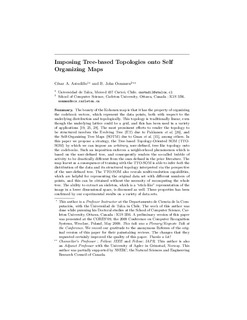| dc.contributor.author | Astudillo, César A. | |
| dc.contributor.author | Oommen, B. John | |
| dc.date.accessioned | 2012-01-25T14:10:54Z | |
| dc.date.available | 2012-01-25T14:10:54Z | |
| dc.date.issued | 2011 | |
| dc.identifier.citation | Astudillo, C. A., & Oommen, B. J. (2011). Imposing tree-based topologies onto self organizing maps. Information Sciences, 181(18), 3798-3815. doi: 10.1016/j.ins.2011.04.038 | no_NO |
| dc.identifier.issn | 0020-0255 | |
| dc.identifier.uri | http://hdl.handle.net/11250/137893 | |
| dc.description | Accepted version of an article from the journal Information Sciences. Definitive published version available on Elsevier Science Direct: http://dx.doi.org/10.1016/j.ins.2011.04.038 | no_NO |
| dc.description.abstract | The beauty of the Kohonen map is that it has the property of organizing the codebook vectors, which represent the data points, both with respect to the underlying distribution and topologically. This topology is traditionally linear, even though the underlying lattice could be a grid, and this has been used in a variety of applications [23,35,40]. The most prominent efforts to render the topology to be structured involves the Evolving Tree (ET) due to Pakkanen et al. [36], and the Self-Organizing Tree Maps (SOTM) due to Guan et al. [18], among others. In this paper we propose a strategy, the Tree-Based Topology-Oriented SOM (TTOSOM) by which we can impose an arbitrary, user-defined, tree-like topology onto the codebooks. Such an imposition enforces a neighborhood phenomenon which is based on the user-defined tree, and consequently renders the so-called bubble of activity to be drastically different from the ones defined in the prior literature. The map learned as a consequence of training with the TTOSOM is able to infer both the distribution of the data and its structured topology interpreted via the perspective of the user-defined tree. The TTOSOM also reveals multi-resolution capabilities, which are helpful for representing the original data set with different numbers of points, and this can be obtained without the necessity of recomputing the whole tree. The ability to extract an skeleton, which is a "stick-like" representation of the image in a lower dimensional space, is discussed as well. These properties has been confirmed by our experimental results on a variety of data sets | no_NO |
| dc.language.iso | eng | no_NO |
| dc.publisher | Elsevier | no_NO |
| dc.title | Imposing tree-based topologies onto self organizing maps | no_NO |
| dc.type | Journal article | no_NO |
| dc.type | Peer reviewed | no_NO |
| dc.subject.nsi | VDP::Mathematics and natural science: 400::Mathematics: 410::Topology/geometry: 415 | no_NO |
| dc.subject.nsi | VDP::Mathematics and natural science: 400::Information and communication science: 420::Algorithms and computability theory: 422 | no_NO |
| dc.source.pagenumber | 3798-3815 | no_NO |
| dc.source.volume | 181 | no_NO |
| dc.source.journal | Information Sciences | no_NO |
| dc.source.issue | 18 | no_NO |
